
The 2020 election upended the power dynamics in Washington D.C., putting the Democrats in charge of the Executive Branch as well as both chambers of Congress. But with narrow majorities in the House and Senate and several Democrats with conservative constituencies who have made clear they may not always follow the party line, addressing immigration will require consensus. In the first week of his administration, President Biden brought the issue front and center by proposing the U.S. Citizenship Act of 2021, which seeks to establish an 8-year road map for granting citizenship to much of the country’s undocumented population and individuals with temporary status, while rethinking our approach to border security and Central America, immigration courts and detention.
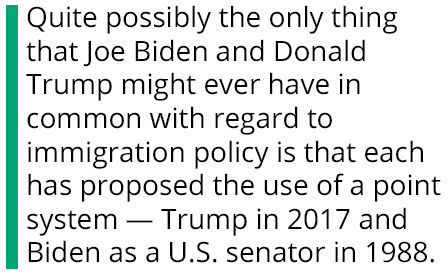 Still lurking in the background, though, is the dire need to overhaul the country’s system for legal immigration — a need widely acknowledged on both sides of the aisle and in the general public. According to a July 2020 Gallup poll, “more Americans support increasing immigration than decreasing it” — a first in 55 years of polling that question. Support for decreasing immigration has dropped sharply from 50 percent in 2009 to 28 percent and 77 percent of Americans categorize immigration as “a good thing.” As energy flows toward reinventing and optimizing the system, one model consistently resurfaces.
Still lurking in the background, though, is the dire need to overhaul the country’s system for legal immigration — a need widely acknowledged on both sides of the aisle and in the general public. According to a July 2020 Gallup poll, “more Americans support increasing immigration than decreasing it” — a first in 55 years of polling that question. Support for decreasing immigration has dropped sharply from 50 percent in 2009 to 28 percent and 77 percent of Americans categorize immigration as “a good thing.” As energy flows toward reinventing and optimizing the system, one model consistently resurfaces.
A point system, sometimes referred to as a “merit-based” system, has been touted by conservatives from Stephen Miller to Tom Cotton, and implemented by liberal governments in New Zealand, Australia, and Canada. Quite possibly the only thing that Joe Biden and Donald Trump might ever have in common with regard to immigration policy is that each has proposed the use of a point system — Trump in 2017 and Biden as a U.S. senator in 1988.
The wide appeal is rooted in the system’s transparency and flexibility. The basic idea is to set up selection criteria and corresponding point values that are then used to assess each immigration applicant; an individual must meet a required point total to be considered for legal residency status. The most important, perhaps pivotal, feature of the idea is that the categories and values can routinely change to take into account shifts in economic conditions, political consensus, or other determinative factors.
 “You can set up points for anything you want,” says Stephen Yale-Loehr, a professor at Cornell University who released an April 2019 report that detailed a model for a pilot point program. “In the system we came up with we suggested offering points if you’re a woman, or if you come from a developing country. Traditional point systems would be biased toward white males from European countries. So the question is how do you overcome that? It’s easier for someone in Europe to have a PhD than someone in Africa.”
“You can set up points for anything you want,” says Stephen Yale-Loehr, a professor at Cornell University who released an April 2019 report that detailed a model for a pilot point program. “In the system we came up with we suggested offering points if you’re a woman, or if you come from a developing country. Traditional point systems would be biased toward white males from European countries. So the question is how do you overcome that? It’s easier for someone in Europe to have a PhD than someone in Africa.”
The possibilities are, theoretically, endless when it comes to creating categories, which makes clear that a point system is a tool, not an outcome. It can be shaped to deliver any objective, from dramatically expanding immigration to dramatically reducing it.
Abul Rizvi, Australia’s Deputy Secretary for Immigration from 2007 to 2015, implemented that country’s point system. While he’s a staunch advocate for the approach, he does caution against viewing it as a panacea or overselling its potential. “Too often,” he says, “when governments such as the United States talk about a points-based system, it almost sounds as if it’s an end in itself. What is never clear when they talk about a points-based system is, what’s the objective you’re trying to achieve? If you can’t articulate clearly what you’re trying to achieve, whether you use a points-based system or not is neither here nor there.”
In Australia, Rizvi says, the point system was created in 1989 to increase immigration in order to address the country’s shrinking population and fill anticipated labor market gaps. Yet in the U.S., the most recent bill to introduce a point system, the 2017 RAISE Act, suggested using criteria that would have shrunk permitted immigration by half, from approximately 1 million annually to 500,000.
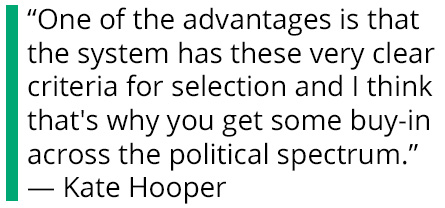 Point systems elicit complex reactions. “In the US, the biggest obstacle to a point system is philosophical,” says Demetrios Papademetriou, the self-described “pro-immigrant” co-founder of the Migration Policy Institute. He’s been analyzing and writing about point systems for the past four decades. “As long as we keep having the conversations we’ve been having going back to the1980s, we’re not going to be able to come up with immigration policies that really serve our national interests. We get stuck on the values, we get stuck on arguments and incantations about the Statue of Liberty. If you want to be and stay competitive you’re going to have to think hard about who can serve the interests of the country. You have to put values and interests in the proper perspective.” A point system, says Papademetriou, can help you do that.
Point systems elicit complex reactions. “In the US, the biggest obstacle to a point system is philosophical,” says Demetrios Papademetriou, the self-described “pro-immigrant” co-founder of the Migration Policy Institute. He’s been analyzing and writing about point systems for the past four decades. “As long as we keep having the conversations we’ve been having going back to the1980s, we’re not going to be able to come up with immigration policies that really serve our national interests. We get stuck on the values, we get stuck on arguments and incantations about the Statue of Liberty. If you want to be and stay competitive you’re going to have to think hard about who can serve the interests of the country. You have to put values and interests in the proper perspective.” A point system, says Papademetriou, can help you do that.
***
In his 2019 proposal, “A Realistic Road to a Points-Tested Visa Program in the United States,” Yale-Loehr suggested test-driving a point system without forcing any lasting decision. His pilot program would manage 50,000 visas per year — roughly five percent of the country’s ordinary annual immigration. The point categories would include education, age, language proficiency (credit not just for fluency in English but also multilingualism) and employability.
Point systems are mostly framed in economic terms. They offer a way to assess how an individual might fill a hole in the job market or contribute to the country’s productivity. Legislators across the political spectrum who advocate for increasing immigration often dwell on economic factors of this sort. But Yale-Loehr’s model also considers demographic characteristics, such as whether or not an immigrant already has family support in the country. This breadth of concern demonstrates that while economics plays a central role in most point systems, there is always room for “human capital” considerations, too.
 “I think another component is creativity,” says Kate Hooper, a senior analyst at the Migration Policy Institute who co-authored a 2019 report on point systems with Papademetriou. “[Considering] the big picture about where shortages are, what skills are in demand, but also to think creatively about ways in which point systems can serve other immigration goals. Can they be used to admit entrepreneurs alongside people who might find employment? Can they help meet needs in regions outside of major cities, for example? I think that’s one of the things that the point system allows — an extra degree of creativity beyond an employer-sponsored system.”
“I think another component is creativity,” says Kate Hooper, a senior analyst at the Migration Policy Institute who co-authored a 2019 report on point systems with Papademetriou. “[Considering] the big picture about where shortages are, what skills are in demand, but also to think creatively about ways in which point systems can serve other immigration goals. Can they be used to admit entrepreneurs alongside people who might find employment? Can they help meet needs in regions outside of major cities, for example? I think that’s one of the things that the point system allows — an extra degree of creativity beyond an employer-sponsored system.”
Hooper also emphasizes the importance of transparency in a point system. “One of the advantages is that the system has these very clear criteria for selection,” she says, “and I think that’s why you get some buy-in across the political spectrum. It’s very clear when you are, for example, prioritizing high-skilled immigrants or people with skills in particular areas or particular types of work experience. It offers an additional degree of clarity to people who are interested in how immigration systems work. It also seems quite scientific; the criteria are quite objective. You’ve got this quite clear checklist that you’re looking through, and I think that can appeal to people as a result.”
Another appeal is the flexibility of a point system, the idea that categories and values can and should be adjusted regularly. The model that Yale-Loehr produced is designed to stop after 10 years so that it can be evaluated. “You can re-evaluate a system as often as you want, actually,” says Yale-Loehr. “Maybe the number of temporary workers should fluctuate depending on how the economy is doing. Maybe we should be allowing in more temporary workers when our economy is booming and fewer when there is a recession with more U.S. workers trying to find jobs. Right now we just have a generic cap.”
The endless tinkering makes the point system idea widely palatable because the outcomes are never fixed. Each legislator knows that supporting a point system doesn’t lock in the trajectory of immigration for generations. Practically speaking, it allows the system to be responsive to changes in the labor market, population growth, median age, political winds and other factors that drive attitudes and realities about immigration. “Bureaucrats have an unending ability to fine-tune point systems,” says Rizvi. “For example, one dimension we used [in Australia] was you had to have a minimum level of English language ability. Secondly, you had to have a minimum level of recognized skill. Skills had to be tested by the appropriate skills-assessing body, the relevant body for dentists, engineers and so forth. Then, you could fine-tune it even further in terms of age, so you could target the precise age group that you wanted. All of it with the objective of maximizing the employment status of the migrants as quickly as possible. The criteria for success was how quickly did that person get a well-paying job using their skill after arrival.”
To that end, Australia introduced extensive longitudinal surveys that tracked how newly arrived immigrants fared at various stages after arrival, including whether or not they secured a job and long-term housing. “So we have a very good idea,” says Rizvi, “of what kinds of impact you have in terms of employability when you change the dial. You really do need to have an understanding of where you want your population to head.”
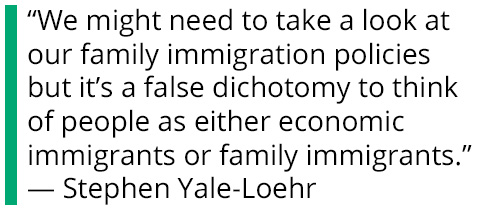
Hooper echoes Rizvi on the importance of responsiveness in any successful point system, adding that simplicity matters, too. “I think these points systems can be as complex as you want them to be,” Hooper says, “but the consideration is always simplicity. It’s much easier for someone to work out that they’re eligible if they have to go through quite a short checklist that has, say, five different things you need [in order] to qualify for [entry] versus this very granular detail of what is your experience, what is your documentation, do you have ties to the country? Basically the more detailed you get the harder it is for an immigrant to navigate the system.
The required flexibility, the balance between granularity and simplicity, is easier to obtain in Australia or Canada where a parliamentary form of government can adjust point values more expeditiously than is the case in the U.S. where changing existing laws requires going back through a polarized Congress. But there are other options, including the possibility of an independent panel or government office charged with managing evaluation of the system and empowered to adjust point values and categories.
Richard Vedder, who worked for the Joint Economic Committee of Congress in the 1980s and is now Professor Emeritus of Economics at Ohio University, says it’s reasonable to imagine a body that operates with independence similar to that which is granted to the Federal Reserve. “The Fed,” Vedder notes, “has had a rules approach. For example, right now a Fed rule of thumb is that we want inflation in the United States not to exceed 2 percent a year. That’s the current rule. It’s no law, the Congress never passed it. It was something the Federal Reserve Board of Governors or its Open Market Committee decided. So you could give administrators, let’s call them bureaucrats, discretion, which is to say they can modify the points, maybe not only every two or three years, but annually. You give them a little bit of discretion.” Vedder does note, however, that the challenge with such an approach is one of perception. “If you give them a lot of discretion, then our immigration laws are being determined by administrators, by the administrative state as it were, rather than by the normal democratic process. And there’s some risk there, too. But you could have a rules approach, giving a body some discretion but constrain it somewhat by rules.”
Vedder has written about the importance of making the immigration application process a financial net positive. In Australia there are fees for filing the application as well as fees associated with some of the required component parts — skills and language tests. The revenue generated is handled through Australia’s tax system and not only pays for the program but generates profit. Vedder envisions the possibility of fees being as fluid as a point system, itself. “The amount you pay for a visa,” he says, “literally could change every day, or even every hour. I think there would be ways that it could be financed, find some financial institutions who love to make money and they might jump into this market.”
Vedder says the profitability of a system could be the decisive selling point for skeptical taxpayers worried about potential costs. “It might soften opposition to immigration,” he says, “and increase the awareness on the part of the native-born population that immigrants can, in fact, have a positive impact. They do have a positive impact, by the way, but some of the gains from immigration are sort of hidden and subtle. This would be a very unsubtle, a very direct way of increasing public support.”
***
The most significant challenge to adopting a point system might be the threat it poses to family-based immigration. For more than 50 years the U.S. immigration system has been largely defined by family-based admissions. Roughly two-thirds of those granted permanent residency in the country gain their status as the child, spouse, sibling, or parent of a U.S. citizen. This is the inverse of most other nations in the world, where economic visas account for most of the immigration and family is defined more strictly as partners and children. In the U.S., an expansive definition of family remains the core policy, and other visa categories — scores of them — are tacked on around the edges.
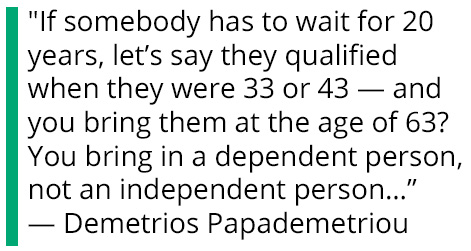 But experts caution against framing the discussion as a zero-sum game between a point system and a family-based system. “We might need to take a look at our family immigration policies,” says Yale-Loehr, “but it’s a false dichotomy to think of people as either economic immigrants or family immigrants. When they come in based on family characteristics they work, and when they come in to work, they bring their family.”
But experts caution against framing the discussion as a zero-sum game between a point system and a family-based system. “We might need to take a look at our family immigration policies,” says Yale-Loehr, “but it’s a false dichotomy to think of people as either economic immigrants or family immigrants. When they come in based on family characteristics they work, and when they come in to work, they bring their family.”
There is little disagreement about whether or not a person who has a work visa should be able to bring a partner and children with them but when it comes to siblings and parents, things turn gray. Voices across the political spectrum have suggested a more measured approach when considering entry for extended family members. “We might have to reduce family migration by a certain percentage,” says Papademetriou. “We are the only country on Earth to have [so many] different family categories. It’s absurd and it violates a certain principle that we say we subscribe to, mainly that you have to unify the closest family members. Sixty thousand visas going to siblings is really an absurdity. You only do that when you really want population growth.”
At present, an individual applying for permanent residency as the sibling of a U.S. citizen can wait as long as 20 years for a visa, depending on the country of origin. “Think about how bad this is for the country. If somebody has to wait for 20 years, let’s say they qualified when they were 33 or 43 — and you bring them at the age of 63? You bring in a dependent person, not an independent person, and the contributions that immigrants bring through their brawn as much as their brain are extremely important.”
And while a point system might inherently reduce family-based immigration simply because it doesn’t grant visas based on this one factor alone, familial relations with a U.S. citizen can still count as a positive in a more comprehensive evaluation process, just as Yale-Loehr’s model demonstrates.
***
Whatever promise a point system may hold, policy experts stress that it serves as a tool useful for clarity and even-handedness, not as a wholesale fix for the substantive stresses in our immigration system. Asylee and refugee cases, for instance, involve entirely different considerations than those prevailing for ordinary legal immigration applications; indeed, sometimes the decisions on asylee and refugee cases must be made in concert with other countries and international bodies. And economic experts point out that a parallel employer-driven visa system, which is what the U.S. currently uses in part, would have to be maintained in some form, if for no other reason than to meet short-term or sudden labor needs that can’t be predicted.
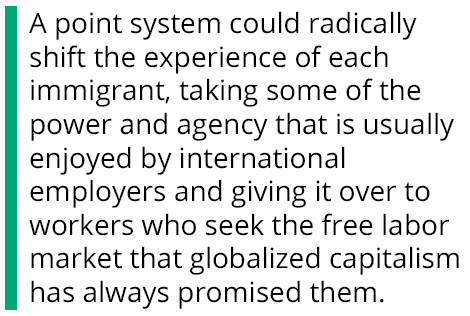 All the more reason to embrace a small-scale pilot program. If it doesn’t work then it’s easily abandoned; if its promise materializes, it could show the way forward. “I don’t think it’s ever going to be easy to make a system for any country,” says Yale-Loehr, “but I think we could at least make the system more transparent for both employers, Americans, and potential immigrants.”
All the more reason to embrace a small-scale pilot program. If it doesn’t work then it’s easily abandoned; if its promise materializes, it could show the way forward. “I don’t think it’s ever going to be easy to make a system for any country,” says Yale-Loehr, “but I think we could at least make the system more transparent for both employers, Americans, and potential immigrants.”
Demetrios Papademetriou takes it one step further. He predicts that a point system could not only improve the country’s immigration system and economic prospects but it could also radically shift the experience of each immigrant, taking some of the power and agency that is usually enjoyed by international employers and giving it over to workers who seek the free labor market that globalized capitalism has always promised them. “If you go after the top people,” says Papademetriou, “you will see a terrain that shifts whereby governments who are seeking to recruit the very best people are no longer in the driver’s seat. Because the best people, once they find a way to advertise their wares and they have some experience in different countries, they have more choices. That means you’re going to see a shift from governments trying to choose the very best people to the people deciding which offer to take.”
Read More:


Ideaspace Interview No. 5

Strategic Inquiry No. 2


